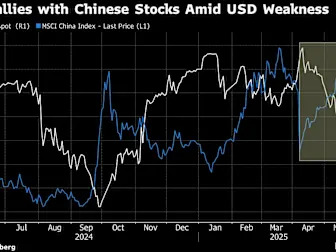(Bloomberg) -- Chinese stocks are expected to benefit from further gains in the yuan, which has been showing resilience amid the country’s trade spat with the US, according to strategists at Goldman Sachs Group Inc.
Every 1% appreciation of the yuan versus the dollar can boost Chinese equities by 3% thanks to factors including improved corporate earnings outlook and stronger foreign inflows, strategists including Kinger Lau wrote in a note Monday. Earlier this month, the bank raised its 12-month forecast for the yuan to 7 per dollar, from 7.35.
“Chinese stocks tend to perform well when the currency rises,” Lau and his colleagues wrote. The outlook for the currency lends support to their “overweight stance” on Chinese stocks, the strategists said, adding that consumer discretionary, property and broker stocks typically outperform under a strengthening yuan.
The MSCI China Index has recouped its losses since President Donald Trump’s April 2 tariff offensive, with a three-month trade truce with the US helping the market’s rebound. Chinese assets overall have benefited from a diversification away from US markets as concerns about Trump’s tariffs and tax cuts sustain the “sell America” narrative.
While investors continue to doubt the allure of US stocks and the dollar, the People’s Bank of China has sought to keep the yuan stable and add support to the economy via interest-rate cuts.
Market volatility from tariff uncertainties has caused Goldman strategists to revise their targets for Chinese stocks with notable frequency. They reduced their MSCI China projection twice in April, before raising it back in May as the US and China agreed to temporarily roll back tariffs.
The MSCI gauge and the Hang Seng China Enterprises Index fell more than 1% each on Monday. That’s after capping six straight weeks of gains.
The onshore yuan has gained around 1.4% versus the greenback in May, and reached 7.1674 on Monday, its strongest level since November.
On Monday, the PBOC strengthened the yuan’s reference rate by the most since January amid the greenback’s extended slide. The official fixing of 7.1833 per dollar was still weaker than the yuan’s spot price, suggesting China is managing volatility and seeking to avoid a sharp appreciation like that seen in the Taiwanese dollar.
The yuan closed on Friday at a level that was stronger than the day’s fixing for the first time since November.
--With assistance from John Cheng and Tian Chen.
(Updates with Goldman’s MSCI China target changes and yuan chart from 6th paragraph.)


